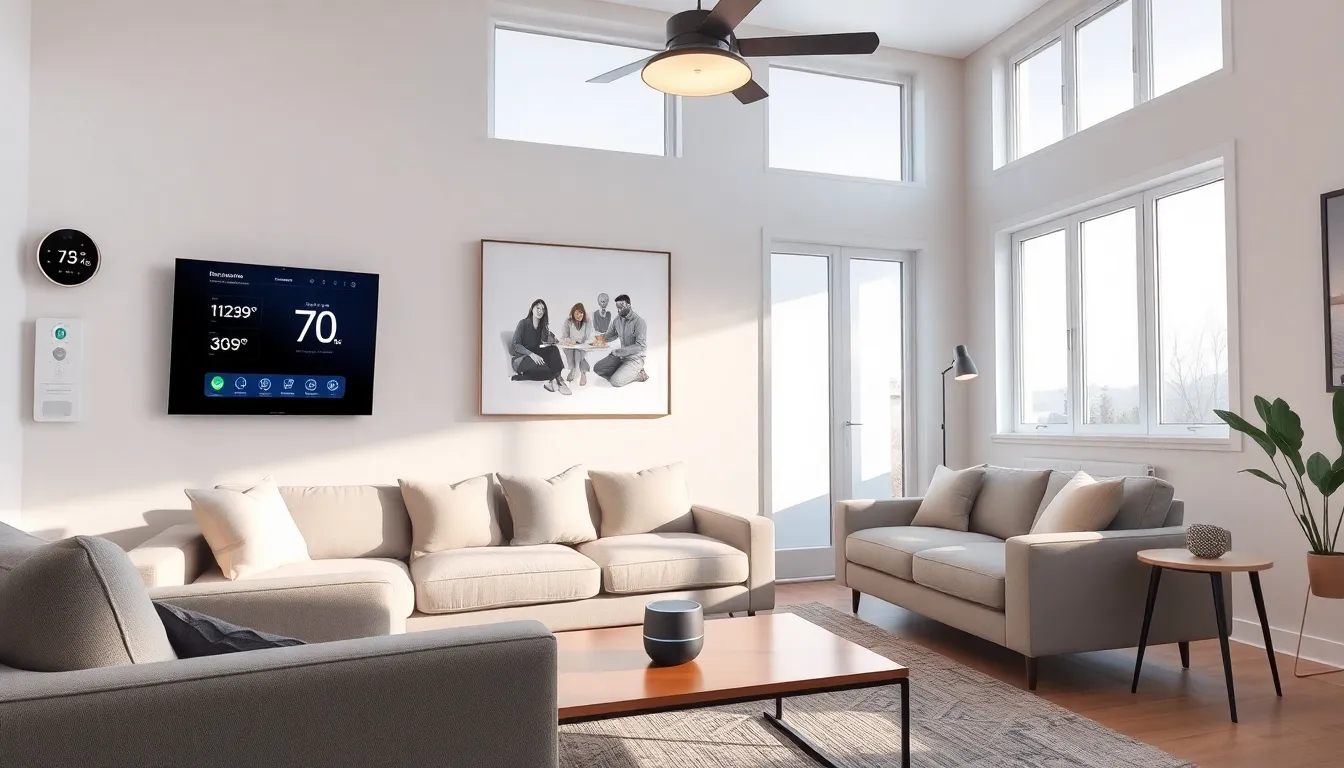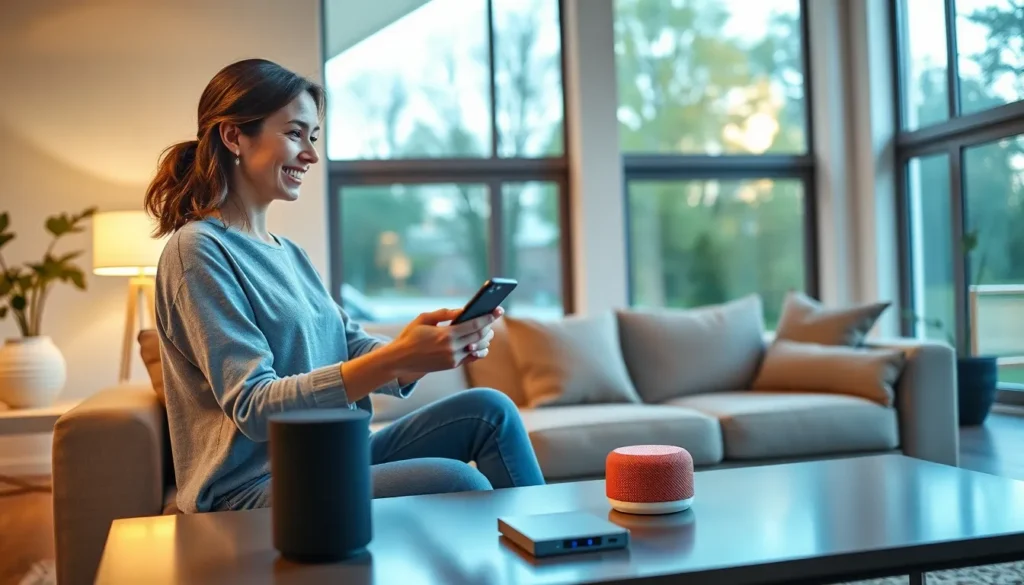Imagine a home that knows you better than your best friend. A place where the lights dim when it’s movie time and the thermostat adjusts itself to the perfect temperature without you lifting a finger. Welcome to the world of smart home design, where technology meets comfort in a way that makes life not just easier, but downright enjoyable.
Table of Contents
ToggleUnderstanding Smart Home Design
Smart home design integrates advanced technology to create intuitive living spaces. This design approach promotes enhanced comfort and efficiency, making residences more responsive to their inhabitants.
Definition of Smart Home Design
Smart home design refers to incorporating connected devices and systems that automate household tasks. Devices such as smart thermostats, lighting systems, and security cameras communicate with each other, providing users with control through smartphones or voice assistants. Features customizable settings allow homeowners to tailor their environments to personal preferences. This design philosophy emphasizes convenience, security, and energy efficiency, making homes smarter and more adaptable.
Importance of Smart Home Design
Smart home design significantly impacts daily living. It improves energy efficiency, reducing utility bills through automated temperature adjustments and lighting controls. Security features enhance peace of mind. Owners can monitor their homes remotely and receive alerts about unusual activity, ensuring safety. Additionally, smart technology can increase property value, attracting potential buyers interested in modern conveniences. Enhanced user experience results in a lifestyle that prioritizes ease, comfort, and sustainability.
Key Components of Smart Home Design

Smart home design hinges on a few critical components that enhance functionality and comfort. Utilizing the right technology and devices fosters a seamless living environment.
Smart Devices and Technology
Smart devices include various appliances and systems that improve daily tasks. Smart thermostats allow for automatic temperature adjustments based on habits. Security cameras offer real-time surveillance and alerts for suspicious activity. Voice assistants control multiple smart devices through simple commands. Automated lighting systems adjust brightness based on the time of day or occupancy. Homeowners experience increased convenience when these devices work in harmony, streamlining household operations.
Connectivity and Integration
Connectivity is essential for a cohesive smart home experience. Devices require reliable internet connections for effective communication. Integration of systems allows for centralized control via smartphone apps or voice commands. Compatibility between different brands ensures a more flexible setup. Creating routines or scenes enables homeowners to automate multiple actions with a single command. Additionally, integration can improve energy efficiency through optimized device performance and scheduling.
Benefits of Smart Home Design
Smart home design offers substantial advantages that transform everyday living. These benefits include enhanced convenience, improved energy efficiency, and increased security.
Enhanced Convenience
Smart home technology simplifies daily routines. Tasks like adjusting lighting, managing temperature, and controlling appliances occur with ease. Voice assistants or mobile apps handle commands, providing users with instant access to home systems. Customizable settings allow for personalized experiences, ensuring that homes cater to individual preferences. Automation of repetitive tasks means homeowners save time and effort. Offering remote access to home devices creates a seamless lifestyle, enhancing overall day-to-day satisfaction.
Improved Energy Efficiency
Energy efficiency becomes a prominent benefit of smart home design. Smart thermostats adapt to occupancy patterns, minimizing energy use when the home is empty. Automated lighting systems adjust according to natural light, reducing electricity consumption. Data from these devices helps homeowners monitor their usage and identify savings opportunities. Custom schedules further optimize energy management, ensuring that heating, cooling, and lighting align with daily activities. This efficient use of resources leads to lower utility bills and supports environmentally responsible living.
Increased Security
Enhanced security is a critical aspect of smart home design. Security cameras enable homeowners to monitor their property in real time, offering peace of mind. Motion detectors trigger alerts for unusual activity, ensuring that potential issues receive immediate attention. Integration with smart locks allows for remote access control, giving homeowners the ability to grant entry from anywhere. Smart systems can also connect to local emergency services, providing quick response options. Investing in these technologies helps safeguard homes and create a secure environment for families.
Challenges in Smart Home Design
Smart home design faces several challenges, notably compatibility and cost. These factors can significantly impact the success of a smart home setup.
Compatibility Issues
Compatibility among devices poses a common challenge. Different manufacturers often create smart devices that use varying protocols for communication. Smart devices may not seamlessly integrate due to these differences, leading to frustration. Moreover, outdated technology can hinder the adoption of newer devices. Homeowners frequently face dilemmas when trying to connect devices from different brands, which can complicate the user experience. Ensuring compatibility often requires careful research and planning to identify devices that work well together.
Cost Considerations
Cost considerations remain a major hurdle for homeowners. Initial investment in smart devices can be substantial, often ranging from a few hundred to thousands of dollars. Many homeowners hesitate to invest due to perceived expenses associated with setup and installation. Long-term savings from energy efficiency can offset initial costs, yet they become significant after considering maintenance and upgrades. Understanding the balance between upfront costs and potential savings is essential for making informed decisions about smart home investments.
Future Trends in Smart Home Design
Smart home design continuously evolves, driven by emerging technologies and changing consumer preferences. Future trends reflect advancements that enhance functionality, convenience, and sustainability.
Advancements in Technology
Innovative technologies reshape smart home design, making living spaces more intuitive. Artificial intelligence learns occupant preferences and adjusts systems automatically. Voice recognition capabilities improve interaction with smart devices, ensuring seamless control. Integration of Internet of Things presents a network of connected devices that communicate effortlessly. Developing solutions also include enhanced security systems, such as facial recognition for door access or smart security cameras. Overall, advancements contribute to a more interactive and user-friendly smart home experience.
Sustainability and Eco-Friendly Solutions
Sustainability takes center stage in future smart home designs, focusing on energy efficiency and reducing environmental impact. Smart thermostats optimize heating or cooling based on occupancy, minimizing energy waste. Solar panels integrated with smart grids allow for better energy management and cost savings. Additionally, water-saving devices help conserve resources while maintaining comfort. Eco-friendly materials in construction promote a greener lifestyle, attracting environmentally conscious homeowners. With smart technology leading the way, homes not only become more comfortable but also support sustainability efforts.
Smart home design represents a significant shift in how people interact with their living spaces. By embracing technology homeowners can create environments that are not only comfortable but also efficient and secure. The integration of smart devices simplifies daily tasks while enhancing energy management and safety.
As technology continues to evolve the possibilities for smart home design will only expand. Homeowners can look forward to even more intuitive systems that cater to their needs. Investing in smart home solutions is not just about convenience; it’s about creating a sustainable and enjoyable lifestyle that adapts to modern living.





